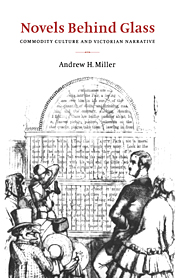Book contents
- Frontmatter
- Contents
- List of illustrations
- Acknowledgements
- Introduction
- 1 Longing for sleeve buttons
- 2 Spaces of exchange: interpreting the Great Exhibition of 1851
- 3 The fragments and small opportunities of Cranford
- 4 Rearranging the furniture of Our Mutual Friend
- 5 Owning up: possessive individualism in Trollope's Autobiography and The Eustace Diamonds
- 6 Middlemarch and the solicitudes of material culture
- Afterword
- Works cited
- Index
Afterword
Published online by Cambridge University Press: 17 August 2009
- Frontmatter
- Contents
- List of illustrations
- Acknowledgements
- Introduction
- 1 Longing for sleeve buttons
- 2 Spaces of exchange: interpreting the Great Exhibition of 1851
- 3 The fragments and small opportunities of Cranford
- 4 Rearranging the furniture of Our Mutual Friend
- 5 Owning up: possessive individualism in Trollope's Autobiography and The Eustace Diamonds
- 6 Middlemarch and the solicitudes of material culture
- Afterword
- Works cited
- Index
Summary
This study began with Vanity Fair and the Great Exhibition, both of which presented goods in the space of exchange, behind lofty plate-glass windows, abstracted from their sites of production and consumption and offered up to the admiring imaginations of gazing viewers. In both Thackeray's novel and the Crystal Palace the traditional emblem of transparent, verisimilar representation, the window, was put to economic purposes. In the chapters that followed, I considered various attempts at resisting the fetishistic gaze encouraged by these windows and their economy of vanity. Each of these novelists (Trollope partially excepted) attempted to construct an alternative understanding of goods, to organize narrative structures in such a fashion that more flexible and generous ways of forming their “external custom” would be possible: Cranford turned to the routines of everyday life; Our Mutual Friend attempted to integrate play with work; and Middlemarch translated economic into aesthetic value.
As Catherine Gallagher writes, Eliot's novel conventionally marks a signal moment of British realism, a defining occasion which provides the aesthetic techniques and concerns that later writers – James and Hardy are the pair traditionally mentioned – develop and extend. Central to these techniques and concerns is the discovery that “the object of representation could be deprived of value in the very process of representing it and that the value thus subtracted from the thing depicted could be appropriated by the representation.”
- Type
- Chapter
- Information
- Novels behind GlassCommodity Culture and Victorian Narrative, pp. 219 - 221Publisher: Cambridge University PressPrint publication year: 1995
- 4
- Cited by



